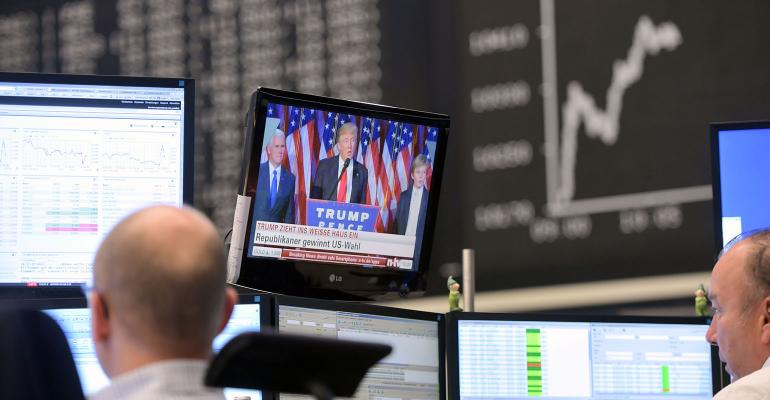By John Detrixhe
(Bloomberg) --Donald Trump’s shock election victory tested trading limits at brokers and trading platforms in Europe, a scenario that was familiar to those stunned by the burst of turbulent trading caused by the U.K.’s Brexit vote in June.
In both cases, the surprise result jolted financial markets that at one point Wednesday saw equity volume that was triple its typical level, while a 5 percent plunge in S&P 500 Index futures triggered a trading halt. Still, there were fewer stock-trading interruptions in Europe so far than after the Brexit vote.
“We all had a dress rehearsal with Brexit,” said Rob Boardman, chief executive officer for Europe of Investment Technology Group Inc., an electronic broker and market operator. “Many firms have been dusting off their Brexit plans, and that’s certainly what we did here. It’s been a little bit chaotic.”
The German stock market Xetra was buffeted by measures that interrupt trading in times of high volatility. Some European banks that provide electronic access to markets adjusted risk checks and tolerances for incoming stock orders, according to Convergex Ltd.’s London-based brokerage.
Price turbulence calmed after a knee-jerk selloff -- futures on the S&P 500 pared the decline to about 2 percent.
Some equities took longer than normal to start trading as the volatility extended opening auctions on stock exchanges, Boardman said. European banks that provide electronic access to markets accepted orders that were further than usual from the previous close because markets had already tumbled.
“We like everybody else will be widening those bands,” he said. “With stocks bouncing around in very volatile trading, it’s legitimate.”
While Asian shares sank by the most since the aftermath of Britain’s vote to leave the European Union, trading was orderly, according to Convergex. The company increased staffing overnight to cope with greater trading in Asia.
London’s stock markets automatically pause after extreme price movements. The London Stock Exchange’s thresholds range from about 3 percent to 10 percent or more. If orders exceed the threshold, the stock automatically goes into an auction before normal trading can resume.
The chief of the biggest pan-European stock market operator said there were fewer trading interruptions than after Brexit in June, which had actually mitigated the pace of buying and selling.
“We’ve seen far fewer go into auction first thing this morning, so there was a little bit of a speedier start, but as soon as it settled down, the overall pace of trading seems somewhat down compared with Brexit day,” said Mark Hemsley, chief executive officer of Bats Global Markets Inc.’s European unit. “We’re even further within capacity as we were during Brexit trading.”
Bats says equities on its European platform are subject to price collars, which reject orders that stray too far from previous reference prices. The thresholds range from about 5 percent to 10 percent.
“The financial market has moved on a lot over recent years. There’s a huge amount of capacity built into the system, there are far more controls in place to manage volatile trading,” said Philip Gough, chief executive officer of Convergex’s European unit. “We’re seeing circuit breakers do their job.”
--With assistance from Will Hadfield. To contact the reporter on this story: John Detrixhe in London at [email protected] To contact the editors responsible for this story: Trista Kelley at [email protected]





